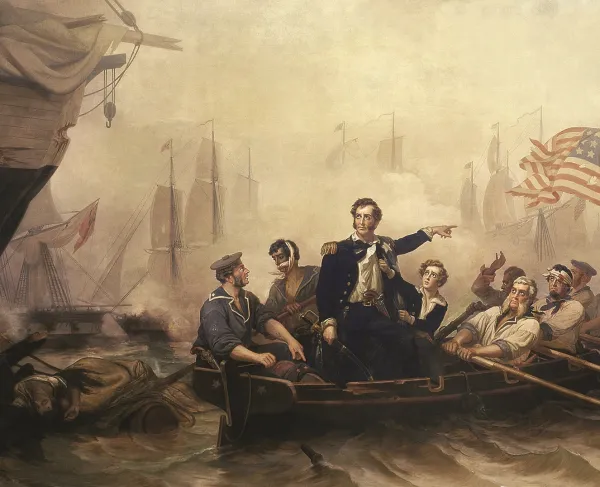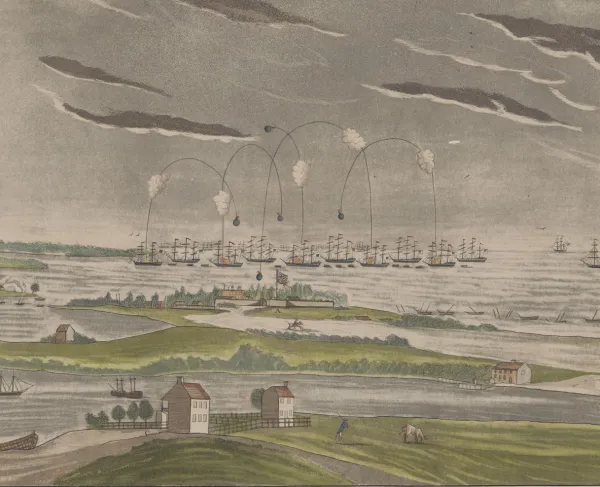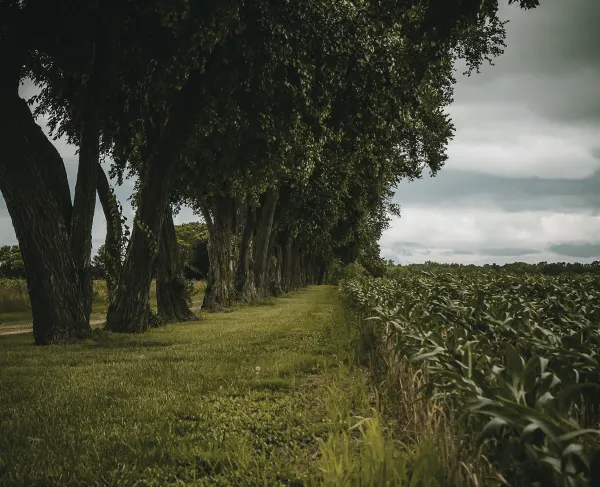A Federal City in Flames
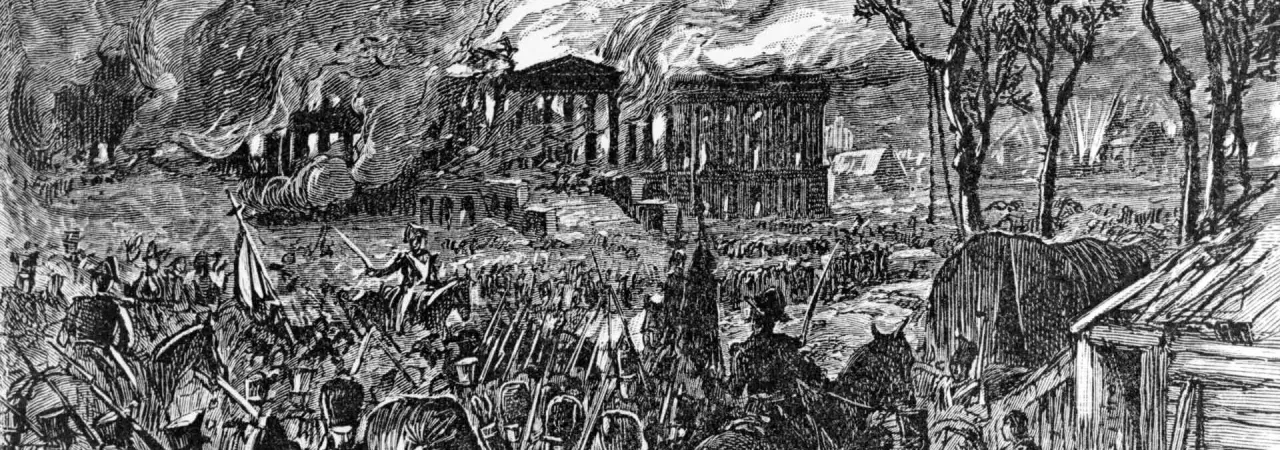
Capture and burning of Washington by the British, in 1814
By the summer of 1814, just thirty years after securing independence from the British, the young United States again found itself engaged in a war with one of its greatest rivals. Following two years of inconclusive fighting, the British had finally begun to gain ground as the warring powers entered their third year of conflict. The defeat of Napoleon’s forces in Europe provided a period of peace that allowed the British to re-focus their efforts on the American Continent. During the Chesapeake Campaign of 1814, British forces, spearheaded by Major General Robert Ross and Rear Admiral George Cockburn, led two major invasions of American territory. The first was an occupation of the new nation’s capital, Washington, D.C., and the second was an assault against Baltimore, one of the country’s most important harbors. That summer, Americans would suffer a mighty blow to their morale as the British raided and set fire to the capital city, burning many of the government buildings that stood as symbols of the young Democracy.
In 1814, Washington, DC, had roughly 8,200 residents. Many of its major structures, including the Capitol Building, were still works in progress. The center of government had only relocated from Philadelphia in 1800, and the city remained comparatively undeveloped, prompting descriptions like that of Attorney General Richard Rush, who observed that the city was merely “a meager village with a few bad houses and extensive swamps.” Washington held little strategic advantage for the British army, but it presented an appealing means of retaliation for an American attack against the Canadian Capital of York a year earlier. On April 27, 1813, Americans had burned and pillaged both public and private property in York, providing the British troops with additional motivation to seek the destruction of the fledgling capital.
Many expected the British to attack Baltimore, Maryland, rather than Washington, since the seaport city was far more strategically significant than the capital. Secretary of War John Armstrong declared that “Baltimore is the place,” the city “of so much more consequence” during the Chesapeake campaign. However, by mid-August, it was becoming clear that the British intended to move against the seat of the American government. James Monroe, then Secretary of State, personally rode towards enemy territory with a scouting party to assess the situation. On August 22, Monroe wrote to President James Madison to warn him that the British were marching towards Washington. He advised making preparations for the defense of the city, noting, “You had better remove the records.”
On August 24, British forces clashed with the Americans in Bladensburg, Maryland, northeast of Washington. The Americans suffered an embarrassing loss, breaking their formations and scattering rather than falling back to defend the capital, opening the way for the British to attack. Later that evening, the British entered the city. For many of Washington’s residents, the invasion came as a frightening and unwelcome surprise. A young British officer, George Robert Gleig recorded the following after witnessing Washington that evening:
I need scarcely observe, that the consternation of the inhabitants was complete, and that to them this was a night of terror. So confident had they been of the success of their troops, that few of them had dreamt of quitting their houses, or abandoning the city; nor was it till the fugitives from the battle began to rush in, filling every place as they came with dismay, that the President himself thought of providing for his safety.
Many citizens fled the city to avoid the incoming British troops, making it difficult to procure horses, carts or wagons as residents struggled to escape with their personal possessions in tow. This situation would later present a serious obstacle for those seeking to save the government’s records.
After their arrival that evening, the British quickly went to work destroying the city’s government buildings. Officer Gleig described how the British soldiers “proceeded, without a moment’s delay, to burn and destroy every thing in the most distant degree connected with government.” The Treasury, State Department, and other federal buildings were razed to the ground. Officer Gleig recorded that “In this general devastation were included the Senate-house, the President’s palace, an extensive dock-yard and arsenal, barracks for two or three thousand men, several large store-houses filled with naval and military stores, some hundreds of cannon of different descriptions, and nearly twenty thousand stand of small arms.” The Navy Yard, too, went up in flames, alongside two American ships, although it was at the orders of the Secretary of the Navy rather than the British. The British soldiers, in fact, received orders not to damage any private property, although few major public buildings within the confines of the city remained intact. Captain Harry Smith, a Junior Adjunct to Major General Ross, left an account of the British exploits which sheds light on some soldiers’ reservations about destroying the capital. Smith observed:
We entered Washington for the barbarous purpose of destroying the city. Admiral Cockburn would have burnt the whole, but Ross would only consent to the burning of the public buildings. I had no objection to burn arsenals, dockyards, frigates building, stores, barracks, etc., but well do I recollect that, fresh from the Duke’s [Wellington] humane warfare in the South of France, we horrified at the order to burn the elegant Houses of Parliament [the Capitol] and the President’s house.
The Patent Building, housed in Blodgett’s Hotel, was one of few public buildings to escape this fate. The British troops spared the structure after its superintendent reminded them that its contents were private property. One of the only examples of British troops destroying private property was a house on Capitol Hill. Civilian snipers had used the house as cover when shooting at a party of enemy officers, killing a British soldier and wounding another, as well as killing Major General Robert Ross’s horse. The British burned the house after receiving the unfriendly fire.
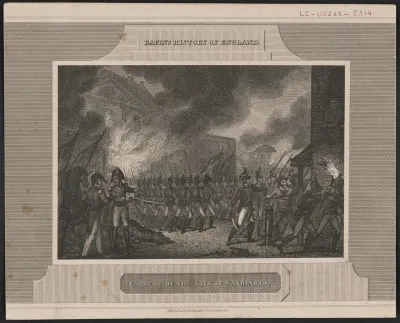
The Capitol building was one of the federal buildings that received the most damage during the invasion, perhaps unsurprisingly, since it stood as a symbol of American democracy. In the summer of 1814, the Capitol building remained unfinished. Nevertheless, it housed both houses of the legislature, as well as the Supreme Court and roughly three thousand volumes that belonged to the Library of Congress. A wooden walkway connected the Senate and House chambers in the north and south wings, although the central part of the building, which would later include the Capitol dome, had yet to be constructed. Once the British troops had entered the north and south wings, they created large bonfires with the building’s furniture. Fires allegedly burned so hot in some parts of the building that marble columns melted down into lime. The flames destroyed the columns that had been specially carved by Italian artists, as well as an eagle hanging above the Speaker’s chair in the House of Representatives. Despite the damage the building sustained, architect Benjamin Henry Latrobe’s choice to use mostly fire-resistant materials for the project, in combination with the incomplete state of the structure, meant that the building was not completely destroyed after the British set it on fire. Today, the sections of the building that survived the fire can still be seen in the Small House Rotunda.
Though the British troops succeeded in damaging the highly symbolic Capitol, several made note of its impressive architecture before setting it ablaze. Officer Gleig described the structure as “an edifice of great beauty.” Similarly, Sir James Scott observed that “it was an unfinished but beautifully arranged building; the interior accommodations were upon a scale of grandeur and magnificence little suited to pure republican simplicity.” Scott, however, had few reservations about razing the structure, despite its regal appearance, claiming that “The Capitol received the fate for which its late proprietors had thoughtlessly reserved it, by converting it into a place of arms.” When describing the sight of the city’s buildings on fire, Officer Gleig recalled that the “The sky was brilliantly illuminated by the different conflagrations; and a dark red light was thrown upon the road, sufficient to permit each man to view distinctly his comrade’s face.” He continued to express that “Except the burning of St. Sebastian’s, I do not recollect to have witnessed, at any period of my life, a scene more striking or more sublime.”
Though the fates of most federal buildings were sealed in flame, some of their contents fared slightly better, thanks to a number of concerned government officials who sought to save some of the young nation’s most important documents. Many young men had been called to arms to help defend against the British attackers, but a number of the civilians and government officials who remained in the city made efforts to save what records and documents they could. State Department Officials acted quickly to remove the Articles of Confederation, George Washington’s commission, Congressional papers, the Declaration of Independence, the Constitution and the Bill of Rights. A young official named Stephen Pleasonton and several other department clerks stored the documents in coarse linen bags and then transported them out of the city on carts. Two staff members from the Library of Congress, Under Librarian J.T. Frost, and another staffer, Samuel Burch, recorded in a letter that on the evening of August 22, they had succeeded in securing the use of a cart, which was “immediately laden with the most valuable records and papers, which were taken, on the same night, nine miles, to a safe and secret place in the country.” Several other government officials also worked to remove some of the most important documents from harm’s way. In the Senate, two younger clerks took it upon themselves to save as much of the legislature’s archival material as they could. Like many of the other government officials who sought to remove important documents from the city, Lewis Machen and John McDonald struggled to find adequate transportation out of the city. The pair finally procured a wagon after threatening to impound it, and after several mishaps along the road, succeeded in removing the documents to the village of Brookeville, Maryland.
After the British had raided the Capitol building, they moved down Pennsylvania Avenue towards one of the most famous buildings to burn during the invasion: the White House, or the Presidential Mansion, as it was called in its first years as the Executive’s residence. Constructed in the final decade of the eighteenth century, the Presidential Mansion was still unfinished when John and Abigail Adams moved into the residence in 1800. When James and Dolley Madison moved in, following the third president’s ascension to office in 1809, Dolley worked to make the Executive Mansion a center of social activity for Washington’s most politically and financially important residents. Dolley established many of the roles of the First Lady, redecorating the residence, holding regular dinner parties, and hosting weekly receptions in the residence’s finest drawing rooms. Little did she know that British troops would destroy these rooms during their invasion of the capital.
Around midnight, a party of British soldiers, led by Admiral Cockburn, arrived at the White House. President Madison and the First Lady had both fled separately into Virginia several hours before.
When the British troops arrived to find the Executive Mansion empty, they promptly helped themselves to the dinner that had been prepared for one of the First Lady’s weekly receptions prior to the evacuation. Captain Harry Smith reported finding “a supper all ready, which was sufficiently cooked without more fire, and which many of us speedily consumed, unaided by the fiery elements and drank some good wine also.” Paul Jennings, one of the Madisons’ slaves and the President’s valet, also commented on the British soldiers’ feast, recalling that “When the British did arrive, they ate up the very dinner, and drank the wines, &c., that I had prepared for the President’s party.”
The soldiers then took several items from the mansion as commemorative tokens of their conquest before setting the building ablaze. However, some of the worst theft to take place in the Executive Mansion and other private properties during the invasion was not occasioned by the British, but rather at the hands of looters who decided to capitalize on the city’s abandoned homes and buildings. Paul Jennings described how most citizens had fled the city in the hours leading up to British troops’ arrival, but “in the mean time, a rabble, taking advantage of the confusion, ran all over the White House, and stole lots of silver and whatever they could lay their hands on.” Nearly all of the Executive Mansion’s furniture perished in the fire, with the exception of one of President Madison’s medicine chests and a portrait of George Washington that has become famous for the dramatic tale of its rescue.
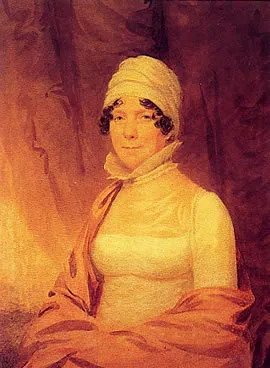
Perhaps the most well-known incident to occur during the Burning of Washington and the destruction of the Presidential Mansion was Dolley Madison’s triumph in saving several of the residence’s most valuable objects, including a number of official cabinet documents, and Gilbert Stuart’s revered portrait of George Washington. Stuart’s painting depicted Washington in 1797, the final year of his presidency. The federal government had purchased the painting for $800 in 1800, as a portrait for the Executive Mansion, and Dolley intended to see that it was safely removed before she fled the residence. Dolley remained in the White House long after most of its staff and inhabitants had fled in order to save the portrait, which was hanging in the mansion’s dining room. Though many warned her that it was time to flee, the First Lady refused to leave until the portrait was secured, instructing her companions to “Save that picture!” and declaring that “Under no circumstances allow it to fall into the hands of the British.”
Under Dolley’s direction, Paul Jennings and another household servant began to unscrew the frame from the wall, but when they could not remove the painting quickly enough, a French steward named Jean-Pierre Sioussat stepped in, carefully cutting the canvas from the frame in order to prevent additional damage. Two New Yorkers, named Jacob Barker and Robert DePeyster then transported the painting out of the city to the Maryland countryside, where it remained for several weeks. Dolley described the proceedings in a letter to his sister, written on the afternoon of the invasion:
Our kind friend, Mr. Carroll, has come to hasten my departure, and is in a very bad humor with me because I insist on waiting until the large picture of Gen. Washington is secured, and it requires to be unscrewed from the wall. This process was found too tedious for these perilous moments; I have ordered the frame to be broken, and the canvass taken out it is done, and the precious portrait placed in the hands of two gentlemen of New York, for safekeeping.
After seeing to the portrait’s successful removal, Dolley did leave the White House, stopping briefly at the home of Charles Carroll in Georgetown before escaping into Virginia. Though there are differing accounts of the proceedings, it is clear that Dolley Madison acted bravely and decisively to save the priceless work of art. Today, the portrait hangs in the East Room of the White House. Down the hall, Dolley Madison’s portrait hangs facing Washington’s, so that she might continue to keep an eye on the nation’s first President. Following its destruction in 1814, the original architect, James Hoban returned to rebuild the mansion, which was ready for President James Monroe to move in in 1817. Burn marks can still be seen on some of the marble blocks that make up the White House today.
One of the strangest events to take place during the invasion of Washington was beyond the control of either the Americans or the British. On August 25, an unusually severe storm raged through the city. Accounts of the storm confirm that it not only extinguished the fires, but damaged property and even leveled some buildings. Sir James Scott recalled that the storm was “one of the severest squalls, or more properly speaking tornadoes, which I have ever witnessed.” He continued to illustrate the scene, describing how the “trees were uprooted, plantations destroyed, and houses blown down.” Officer Gleig recalled that “The flashes of lightening seemed to vie in brilliancy, with the flames which burst from the roofs of burning houses, while the thunder drowned the noise of crumbling walls, and was only interrupted by the occasional roar of canon, and of large depots of gunpowder, as they one by one exploded.” Sir Scott concluded that the storm “was of brief duration, or the devastation to Washington would have proved of far greater magnitude than the mischief committed by the English.”
The British retreated from the city the next morning, leaving a trail of destruction in their wake. The Burning of Washington resulted in efforts to relocate the capital to another, more developed city. Proponents of this plan had ample ammunition, considering how many of the major government buildings had been destroyed. In spite of these efforts, the capital remained in Washington and work began to rebuild and restore the city. In the immediate aftermath of the invasion, the government adapted to meet their new circumstances. The Madisons moved into the Octagon House, and later into one of the “Seven Buildings” townhouses on Pennsylvania Avenue, where they lived for the remainder of the President’s term. Congress met in Blodgett’s hotel, one of the largest buildings that remained intact, until a temporary facility, the Old Brick Capitol, was built in 1815. It was not until 1819 that Congress would begin to convene once more in the Capitol building. Several weeks after the invasion of Washington, D.C., British forces began to move towards Baltimore and Fort McHenry, in the attack that would inspire Francis Scott Key to write the Star-Spangled Banner. Though the invasion of Washington had proved a destructive event to both the city’s physical geography and the nation’s morale, it would also come to represent the United States’ resilience, as the young nation began to rebuild and redefine itself in the second major fight for American independence.
Related Battles
200
250
